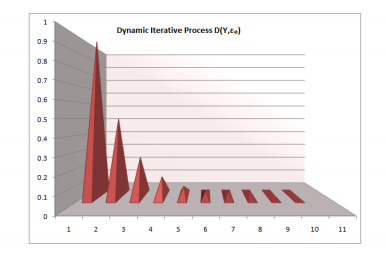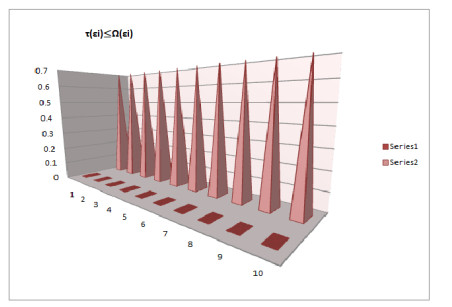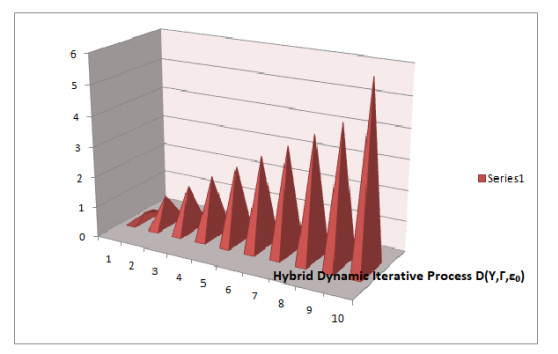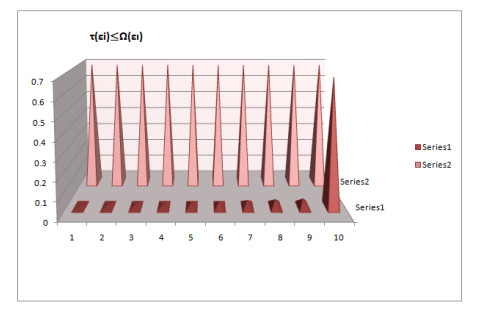1.
Introduction
In the frame of functional analysis, the study of metric fixed point theory (MFPT) untied a portal to a new area of pure and applied mathematics. It states sufficient conditions for the existence of a (unique) fixed point and also provides an iterative system by which we can make approximations to the fixed point and error bounds. This idea was explored and furthered by a good number of researchers (see [2,3,29,31]). It is widely held that MFPT originated in the year 1922 through the work of S. Banach [7] when he established the famous contraction mapping principle (CMP). Iteration systems are used in each branch of applied mathematics, and the criteria for convergence proofs and error estimates are very often produced by an application of the CMP and its variants. Moreover, E. Sperner (1928) proved the combinatorial geometric well-known lemma on the decomposition of a triangle which displays an important rule in the theory of CMP. These are the most important tool for proving tlre existence and uniqueiess of solutions to different mathematical models (differential, integral, ordinary and partial differential quations, variational inequalities). Some other fields are steady-state tempreture ditribution, chemical reactions, neutron transport theoty, economic, flow of fluids, optimal control theory, fractals, etc.
The classical fixed point theorems of Banach and Brouwer marked the development of the two most prominent and complementary facets of the theory, namely, the metric fixed point theory and the topological fixed point theory. The metric theory encompasses results and methods that involve properties of an essentially isometric nature. It originates with the concept of Picard successive approximations for establishing existence and uniqueness of solutions to nonlinear initial value problems of the 1st order and goes back as far as Cauchy, Liouville, Lipschitz, Peano, Fredholm, and most particularly, Emile Picard. The concept was investigated by extending metric spaces into its extensions. Kamran et al. [19] initiated the idea of an extended b-metric space, which is one of the most highlight extension of a b-metric space. After, in 2018, Mlaiki et al. [23] generalized the notion of an extended b-metric space to a controlled metric space. Many recent developments on metric structures and fixed point theory are investigated in [10,12,13] and also in the references therein. Later on, Nadler [24] used the idea of the Pompeiu-Hausdorff metric and gave the contraction theorem for set-valued maps instead of single-valued maps. In 2002, Branciari [9] introduced a well known contraction, known as the Branciari contraction. In 2012, Wardowski [32] initiated a new class of contractions, known as an F-contraction mapping and investigated the existence and uniqueness of fixed point results (see more [14,15,22,26]). Recently, many developments on fractional calculus and fixed point results based on (generalized) F -contraction mappings are investigated in [8,11,20,25,28,33] and also in the references therein in the associated approach.
2.
Preliminaries
Let N(Ψ) represent the family of all non-empty subsets of a non-empty set Ψ, and C(Ψ) be the family of all non-empty closed subsets of Ψ. Let Y:Ψ→N(Ψ) be a set-valued mapping, and ε0∈Ψ be arbitrary and fixed. Define
Any element of ˇD(Y,ε0) is named as dynamic iterative-scheme of Y starting from point ε0. The dynamic-iterative scheme (εj)j∈N∪{0} onward has the form (εj) (see [17]).
Example 2.1. Let Ψ=C([0,1]) be a Banach space with the norm ‖ε‖=supr∈[0,1]|ε(r)| where ε∈Ψ. Let Y:Ψ→2Ψ be so that for every ε∈Ψ, Y(ε) is a collection of the function
that is,
and let ε0(u)=u, u∈[0,1], so (1j!(j+1)!rj+1) is a dynamic process of Y with starting point ε0. The mapping Y:Ψ→R is said to be ˇD(Y,ε0) dynamic lower semi-continuous at ε∈Ψ, if for each dynamic iterative-scheme (εj)∈ˇD(Y,ε0) and for each subsequence (εj(i)) of (εj) converges to ε, we write Y(ε)≤liminfi→∞Y(εj(i)). In this case, Y is ˇD(Y,ε0)-dynamic lower semi-continuous. If Y is ˇD(Y,ε0) dynamic lower semi-continuous at each ε∈Ψ, then Y is known as lower semi-continuous. If for each sequence (εj)⊂Ψ and ε∈Ψ so that (εj)→ε, we write Y(ε)≤liminfi→∞Y(ε(j)) (more see [4,17]).
Branciari [9] introduced the following concepts:
Definition 2.2. [9] Let (Ψ,δ) be a metric space and Y:Ψ→Ψ be so that
for all ε1,ε2∈Ψ, where β∈(0,1), Φ:κ→κ is a non-negative Lebesgue integrable mapping which is summable on each compact subset of κ [κ=[0,+∞)] and ∫ϵ0Φ(s)ds for all ϵ>0. Then, Y has fixed point.
Lemma 2.3. [21] Let (εi)i∈N be a sequence so that limi→+∞εi=ε. Then
Lemma 2.4. [21] Let (εi)i∈N be a sequence. Then
For the last few years, contraction theorems have rapidly been evolving, not only in the metric frame, but also in many different extended spaces and the controlled metric space is one of them. In 2018, Mlaiki et al. [23] generalized the notion of an extended b-metric space to a controlled metric space. Alamgir et al.[1] introduced the idea of a Hausdorff controlled metric and proved some well-known results in control metric spaces.
Definition 2.5. [23] A controlled-metric space on a non-empty set Ψ is a function δς:Ψ×Ψ→R+ with ς:Ψ×Ψ→[1,∞) so that ∀ ε1,ε2,ε3∈Ψ
(C1): if δς(ε1,ε2)=0 if and only if ε1=ε2;
(C2): δς(ε1,ε2)=δς(ε2,ε1);
(C3): δς(ε1,ε3)≤ς(ε1,ε2)δς(ε1,ε2)+ς(ε2,ε3)δς(ε2,ε3).
The pair (Ψ,δς) is known as a controlled-metric space.
A sequence {εi} in controlled m.s Ψ is convergent to some ε∈Ψ if for every ϵ>0, there is I=I(ϵ)∈N so that δς(εi,ε)<ϵ for all i≥I and have write limi→∞(εi)=ε, a sequence {εi} in (Ψ,δς) is Cauchy if for every ϵ>0, there is I=I(ϵ)∈N so that δς(εi,εi′)<ϵ for all i,i′≥I and a controlled-metric space (Ψ,δς) is complete if every Cauchy sequence in Ψ converges.
Let x∈Ψ and ϵ>0, the open ball B(x,ϵ) is
The mapping Y:Ψ→Ψ is continuous at x∈Ψ if for each ϵ>0, there is α>0 so that
Owing to above proposition, we clearly say that if Y is continuous at x∈Ψ, then for xi→x, we have Yxi→Yx as i→∞.
Further, Alamgir et al. [1] discussed some well-known results via the Hausdorff controlled metric. Define the Pompeiu-Hausdorff controlled metric ˆHς induced by δς on CB(Ψ) as follows:
for each θ1,θ2∈CB(Ψ), where ˇD(ε1,θ2)=infε2∈θ2δς(ε1,ε2).
Lemma 2.6. [1] Let θ1 be a nonempty subsets of acontrolled-metric space (Ψ,δ), then
for ε1,ε2∈Ψ, where ς(ε2,θ1)=infε∗∈θ1ς(ε2,ε∗) and δς(ε2,θ1)=infε∗∈θ1δς(ε2,ε∗).
Lemma 2.7. [1] Let θ1,θ2∈CB(Ψ), then for all β>0 and ε2∈θ2, there is ε1∈θ1 so that
Lemma 2.8. [1] Let θ1 and θ2 be nonemptysubsets of a controlled-metric space (Ψ,δ). If α∈θ1, then
In 2012, Wardowski [32] initiated F-contractions and a related fixed point result was presented.
Definition 2.9. [32] Y:Ψ→Ψ is called an F -contraction on a metric space (Ψ,δ), if there exist F∈∇F and τ∈R+/{0} so that δ(Yε1,Yε2)>0, implies
for each ε1,ε2∈Ψ, where ∇F is the family of all functions F:(0,+∞)⟶(−∞,+∞), so that
(Fi) ε1<ε2 implies F(ε1)<F(ε2) for all ε1,ε2∈(0,+∞);
(Fii) for each sequence {ε(j)} of positive real numbers,
(Fiii) there is k∈(0,1) such that limc→0(c)kF(c)=0. Then there is a unique fixed point of Y.
Example 2.10 As examples of F-contractions, one writes:
(i):F(ε)=ln(ε);
(ii):F(ε)=ln(ε)+ε;
(iii):F(ε)=−1√ε;
(iv):F(ε)=ln(ε2+ε).
Owing to (Fi) and (2.1), each F-contraction Y is a contractive mapping, and so each F-contraction mapping is continuous.
Our goal is to introduce a new concept of non-linear (F, FH)-dynamic-iterative scheme for Branciari Ćirić type-contractions and establish some related multi-valued fixed point results on controlled-metric spaces. Finally, we give concrete examples, an application and some open questions.
3.
A family of F-dynamic-iterative scheme: ˇD(Y,ε0)
First, we introduce the following definition.
Definition 3.1. Let (Ψ,δς) be a controlled-metric space and Y:Ψ→CB(Ψ) be a set valued Branciari Ćirić type contraction based on F -dynamic-iterative scheme ˇD(Y,ε0). If there are F∈∇F, τ:(0,+∞)→(0,+∞) a non-constant function and Φ:κ→κ a non-negative Lebesgue integrable mapping which is summable on each compact subset of κ so that
where
for all i∈N, εi∈ˇD(Y,ε0) and for every given ϵ>0 so that ∫ϵ0Φ(s)δs>0.
Remark 3.2. In continuing way of our results, we consider only the dynamic iterative scheme εi∈ˇD(Y,ε0) that verifies the following criteria:
When the process does not verify (3.2), then there is i0∈N so that
and
Then we get εi0−1=εi0∈Yεi0−1 which ensures the existence of a fixed point. In view of this consideration of dynamic iterative scheme satisfying (3.2), it does not depreciate a generality of our analysis.
Remark 3.3. Upon setting, clearly Y is a contraction mapping with respect to F-dynamic iterative scheme ˇDς(Y,ε0) and in the light of Φ(s)≡1, we easily conclude that it is an F-contraction.
Theorem 3.4. Let (Ψ,δς) be a completecontrolled-metric space and Y:Ψ→CB(Ψ) be aset valued Branciari Ćirić type contraction with respect to F-dynamic-iterative scheme ˇDς(Y,ε0). Assume that:
(D1) : There is a F-dynamic iterative scheme εi∈ˇDς(Y,ε0) such that
(D2): A mapping Ψ∋εi⟼δς(εi,Yεi) is ˇDς(Y,ε0)-F-dynamic lowersemi-continuous.
Then Y has a fixed point.
Proof. Choose ε0∈Ψ to be an arbitrary point. In view of εi∈ˇDς(Y,ε0), we design the F-dynamic iterative scheme by the following family:
In case, there is i0∈N so that εi0∈Yεi0, then εi0 is a fixed point of Y is clear. Therefore, if we let εi∉Yεi then ˇDς(Y,ε0)>0 for every i∈N. Since Yεi is compact, by (3.1) and Lemma 2.6, one writes
Moreover, since Yεi is compact, we obtain εi+1∈Yεi so that δς(εi,εi+1)=ˇDς(εi,Yεi). Using (3.3), we have
Thus, the sequence {δς(εi,εi+1)} is decreasing and hence it is convergent. Now, we show that limi→∞δς(εi,εi+1)=0. From, (D1) there is σ>0 and i0∈N so that τ(δς(εi−1,εi))>σ for all i>i0. Hence, we see that
Let us set ϖi=∫δς(εi,εi+1)0Φ(s)δs>0 for i=0,1,2,⋯, and from (3.4), we obtain limi→∞F(ϖi)=−∞. Using (Fii), we get
In view of (Fiii), there is α∈(0,1) so that
By (3.4), the following holds for all i>i0,
Taking limit as i→∞ in (3.7) and using (3.6), we have
Due to (3.8), there is i1∈N so that i[ϖi]α≤1 for all i≥i1, we have
Now, in order to show that {εi} is a Cauchy sequence, we consider j1, j2∈N so that j1>j2≥i1. From (3.9) and by the metric condition, we have
Owing to (3.10) and in view of the convergence of series ∑∞l=j11l1α, we get ∫δς(εj1,εj2)0Φ(s)δs→0. Hence, {εi} is Cauchy in (Ψ,δς). Further, for the completeness of Ψ there is ε∗∈Ψ so that limi→∞εi=ε∗. Since Y is compact, we have Yεi→Yε∗ and by Lemma 2.6, one writes
So, ˇDς(ε∗,Yε∗)=0 and ε∗∈Yε∗. Now, by right continuity of F we examine ε∗∈Yε∗. Suppose on the contrary, ε∗∉Yε∗ then there are i0∈N and a subsequence {εik} of {εi} so that ˇDς(εik+1,Yε∗)>0 for each ik≥i0 [Otherwise, there is i1∈N so that εi∈Yε∗ for every i≥i1, which yields ε∗∈Yε∗, it is a contradiction]. Since ˇDς(εik+1,Yε∗)>0 for each ik≥i0, one writes
Taking a limit as k→∞ in (3.12),
which is a contradiction. Thus, since Ψ∋εi⟼δς(εi,Yεi) is ˇDς(Y,ε0)-F-dynamic lower semi-continuous, we have
The closedness of Yε∗ implies that ε∗∈Yε∗ which means that ε∗ has a fixed point of Y.
Some direct consequences of Theorem 3.4 are as follows:
Remark 3.5. In light of Theorem 3.4, we derive the following contractive condition:
where
for all i∈N, εi∈ˇDς(Y,ε0) and ˆHς(Yεi,Yεi+1)>0. Then, Y has a fixed point.
Corollary 3.6. Let (Ψ,δς) be a completecontrolled-metric space and Y:Ψ→CB(Ψ) be a set-valuedBranciari Ćirić type contraction based on F-dynamic-iterativescheme ˇD(Y,ε0). Suppose for some F∈∇F, τ:(0,+∞)→(0,+∞) a non-constant function and Φ:κ→κ a non-negative Lebesgue integrable mapping which is summable oneach compact subset of κ so that
where
for all i∈N, εi∈ˇDς(Y,ε0), δς(Yεi,Yεi+1)>0 and for each given ϵ>0 such that ∫ϵ0Φ(s)δs>0. Assume that (3.4) and (3.4) are satisfied. Then Y has a fixedpoint.
Remark 3.7. In view of Corollary 3.6, we state the following contractive condition:
where
(i) Δ1(εi−1,εi)=δς(εi−1,εi);
(ii) Δ2(εi−1,εi)=max{δς(εi−1,εi),ˇDς(εi−1,Yεi−1),ˇDς(εi,Yεi)};
(iii) Δ3(εi−1,εi)=max{δς(εi−1,εi),ˇDς(εi−1,Yεi−1),ˇDς(εi,Yεi)2,ˇDς(εi−1,Yεi)+ˇDς(εi,Yεi−1)2}
for all i∈N, εi∈ˇDς(Y,ε0). Then Y has a fixed point.
Corollary 3.8. Let (Ψ,δς) be a completecontrolled-metric space and Y:Ψ→CB(Ψ) be a set-valuedBranciari Ćirić type contraction based on F-dynamic-iterativescheme ˇD(Y,ε0). If for some F∈∇F, τj:(0,+∞)→(0,+∞), j=1,2 a non-constant function and Φ:κ→κ is anon-negative Lebesgue integrable mapping which is summable on each compactsubset of κ so that one of the following holds:
(G1) δς(Yεi,Yεi+1)>0 ⇒τj=1(Δ(εi−1,εi))−1∫ˆHς(Yεi,Yεi+1)0Φ(s)δs≤−1∫Δ(εi−1,εi)0Φ(s)δs;
(G2) δς(Yεi,Yεi+1)>0 ⇒τj=2(Δ(εi−1,εi))+11−exp∫ˆHς(Yεi,Yεi+1)0Φ(s)δs≤11−exp∫Δ(εi−1,εi)0Φ(s)δs,
where
for all i∈N, εi∈ˇDς(Y,ε0) and for each given ϵ>0 sothat ∫ϵ0Φ(s)δs>0. Assume that (D1)and (D2) are satisfied. Then Y has a fixed point.
Proof. The proof directly proceed from Corollary 3.8 based on the functions F(ε)=−1ε and F(ε)=11−exp(ε), which is also fulfilled for the family ∇F, then the result follows.
Example 3.9. Let Ψ=R+∪{0}. Define the complete controlled-metric spaces (Ψ,δς) by
and ς:Ψ×Ψ→[1,∞) as
Consider a mapping Y:Ψ→CB(Ψ) defined by Yε=[0,ε2],ε>0 and τ a non-constant function, that is, τ:R+→R+ is of the form
Consider tghe dynamic iterative process ˇD(Y,ε0): A sequence {εi} is defined by εi=ε0gi−1 for each i∈N with starting point ε0=2 and g=12 so that (see Table 1):
By continuing the above iterative process, one asserts that
is a F-dynamic iterative process of Y starting from ε0=2.
For εi∈ˇDς(Y,ε0) and Y as a Branciari Ćirić type contraction mapping with respect to F-dynamic-iterative scheme ˇDς(Y,ε0), we obtain ˆHς(Yεi,Yεi+1)=|εi−1−εi|2 and Δ(εi−1,εi)=|εi−1−εi|. Now, by contractive condition (3.1) upon setting of F(ε)=ln(ε) and Φ(s)=1 for all s∈R, we see that τ(h)≤Ω(ı), where
Hence, all the required hypotheses of Theorem 3.4 are satisfied and consequently in view of Tables 1 and 2, and Figures 1 and 2, the required hypotheses of Theorem 4.4 regarding to τ(h)≤Ω(ı), are satisfied for all possible values. Here, 0∈Y(0) is a fixed point of Y for a Branciari Ćirić type contraction mapping with respect to F-dynamic-iterative scheme ˇDς(Y,ε0).
4.
A Family of FH-dynamic-iterative scheme: ˇD(ϝ,Y,α0)
Here, we give our second general definition.
Definition 4.1. Let ϝ:Ψ→Ψ and Y:Ψ→CB(Ψ) be so that
for each integer j≥1. The set ˇD(ϝ,Y,α0) is said to be a hybrid dynamic-iterative scheme of ϝ and Y having the starting point α0. The hybrid dynamic-iterative scheme ˇD(ϝ,Y,α0) is shortly written as ϝ(αj).
Definition 4.2. Let ϝ:Ψ→Ψ and Y:Ψ→CB(Ψ) be an hybrid Branciari Ćirić type contraction on the controlled-metric space (Ψ,δς) with respect to FH-dynamic-iterative scheme ˇD(ϝ,Y,ε0). Suppose there are FH∈∇F, τ:(0,+∞)→(0,+∞) a non-constant function and Φ:κ→κ a non-negative Lebesgue integrable mapping which is summable on each compact subset of κ so that
where
for all i∈N, εi∈ˇD(ϝ,Y,ε0) and for each given ϵ>0 so that ∫ϵ0Φ(s)δs>0.
Remark 4.3. Via Remark 3.2, we consider only the FH-dynamic iterative scheme εi∈ˇD(ϝ,Y,ε0) that satisfying the following condition:
If the investigated process that does not satisfy (4.3), then there is some i0∈N so that
and
then we get ϝεi0−1=ϝεi0∈Yεi0−1 which implies the existence of common fixed point. Due to this consideration of FH-dynamic iterative scheme that satisfies (4.3), it does not depreciate a generality of our approach. Moreover, owing to Example 3.2, we easily conclude that the hybrid pair (ϝ,Y) with respect to FH-dynamic iterative scheme ˇD(ϝ,Y,ε0) is a contraction mapping.
Theorem 4.4. Let ϝ:Ψ→Ψ and Y:Ψ→CB(Ψ) be an hybrid Branciari Ćirić typecontraction on the controlled-metric space (Ψ,δς) with respect to FH-dynamic-iterative scheme ˇD(ϝ,Y,ε0). Assume FH(ϝ,Y)≠ϕ, where FH(ϝ,Y) provided that ϝ(Ψ) is complete and Y is a closed multivalued mapping suchthat
(D3) there is an FH-dynamic iterative scheme εi∈ˇD(ϝ,Y,ε0) such that suchthat
(D4) for some ε∈FH(ϝ,Y), ϝ is Y-weakly commuting at ε so that ϝ2ε=Yϝε.
Then the hybrid pair (ϝ,Y) has a common fixed point.
Proof. Consider ε0∈Ψ to be an arbitrary point. In view of (4.1), we have
In case, if there is i0∈N so that εi0∈ϝεi0, then εi0 is a fixed point of ϝ is clear. Therefore, if we let εi∉ϝεi then ˇD(ϝ,Y,ε0)>0 for every i∈N. Using (4.2), one writes
which implies
Based on (4.1) and (4.4), we have
for all i∈N. Due to (Fi), we obtain for some i,
which gives a contradiction. Thus, we get
Consequently,
for all i∈N. Thus, the sequence {δς(εi,εi+1)} is decreasing and hence convergent. Now, we show that limi→∞δς(εi,εi+1)=0. From (3.4) there is σ>0 and i0∈N, so that τ(δς(εi−1,εi))>σ for all i>i0. Thus, we have
Setting ϖi=∫δς(ϝεi,ϝεi+1)0Φ(s)δs>0 for i=0,1,2,... and from (4.6), we obtain limi→∞F(ϖi)=−∞. Using (Fii) implies that
From (Fiii), there is α∈(0,1) so that
By (4.6), the following holds for all i>i0,
Taking limit as i→∞ in (4.9) and using (4.8), we have
Let us perceive that from (4.10), there is i1∈N so that i[ϖi]α≤1 for all i≥i1. We have
Now, we will show that {εi} is a Cauchy sequence. For this mark, we consider j1, j2∈N so that j1>j2≥i1. From (4.11),
which yields
Owing to (4.12) and in view of convergence of series ∑∞l=j11l1α, we get ∫δς(ϝεj1,ϝεj2)0Φ(s)δs→0. Hence, {ϝεi} is Cauchy in ϝ(Ψ). Further, for the completeness of Ψ there is ε∗∈ϝΨ so that limi→∞ϝεi=ε∗. Now, we claim that ϝε∗∈Yε∗. So, δς(ϝε∗,Yε∗)=0 and ϝε∗∈Yε∗. In case, ϝε∗∉Yε∗ then δς(ϝε∗,Yε∗)>0 as ϝ is compact. By (Fi) and Lemma 2.6, we see that
Suppose on the contrary, ϝε∗∉Yε∗ then there are an i0∈N and a subsequence {εik} of {εi} so that δς(ϝεik+1,Yε∗)>0 for each ik≥i0 [Otherwise, there is i1∈N so that ϝεi∈Yε∗ for every i≥i1, which yields ϝε∗∈Yε∗, a contradiction]. Since δς(ϝεik+1,Yε∗)>0 for each ik≥i0, by the contractive condition, one writes
Letting k→∞ in (4.14),
a contradiction. Thus, ϝε∗∈Yε∗, which means that ε∗ has a common fixed point of the hybrid pair (ϝ,Y). Further, for some ε∈FH(ϝ,Y), ϝ is Y-weakly commuting at ε so that ϝε2=ϝε. So we obtain ϝ2ε∈Yϝε. In the light of given hypothesis, we see that ϝε=ϝ2ε and hence ϝε=ϝ2ε∈Yϝε, Consequently, ϝε∈FH(ϝ,Y).
Some direct consequences of Theorem 4.4 are given.
Remark 4.5. In the light of Theorem 3.4, we obtain the following contractive conditions:
(i) τ(∫Δ(εi−1,εi)0Φ(s)δs)+FH(∫δς(ϝεi+1,ϝεi)0Φ(s)δs)≤FH(∫Δ(εi−1,εi)0Φ(s)δs);
(ii) 2τ(∫Δ(εi−1,εi)0Φ(s)δs)+FH(∫δς(ϝεi+1,ϝεi)0Φ(s)δs)≤FH(∫Δ(εi−1,εi)0Φ(s)δs).
Due to above fashion, we easily see that the hybrid pair (ϝ,Y) has a common fixed point.
Corollary 4.6. Let ϝ:Ψ→Ψ and Y:Ψ→CB(Ψ) be an hybrid Branciari Ćirić typecontraction on the controlled-metric space (Ψ,δς) with respect to FH-dynamic-iterative scheme ˇD(ϝ,Y,ε0). Suppose there are FH∈∇F, τj:(0,+∞)→(0,+∞), j=¯1,6 a non-constant function and Φ:κ→κ a non-negative Lebesgue integrable mapping which is summable on eachcompact subset of κ so that δ(ϝαi,ϝαi+1)>0 and one of the following holds:
(G1): τj=1(∫Δ(αi−1,αi)0Φ(s)δs)−1∫δ(ϝαi,ϝαi+1)0Φ(s)δs≤−1∫Δ(αi−1,αi)0Φ(s)δs;
(G2): τj=2(∫Δ(αi−1,αi)0Φ(s)δs)+exp(∫δ(ϝαi,ϝαi+1)0Φ(s)δs)≤(∫Δ(αi−1,αi)0Φ(s)δs);
(G3): τj−=3(∫Δ(αi−1,αi)0Φ(s)δs)+11−exp(∫δ(ϝαi,ϝαi+1)0Φ(s)δs)≤11−exp(∫Δ(αi−1,αi)0Φ(s)δs);
(G4): τj=4(∫Δ(αi−1,αi)0Φ(s)δs)c+(∫δ(ϝαi,ϝαi+1)0Φ(s)δs)c≤(∫Δ(αi−1,αi)0Φ(s)δs)c, c>0;
(G5): τj−=5(∫Δ(αi−1,αi)0Φ(s)δs)−1∫δ(ϝαi,ϝαi+1)0Φ(s)δs+∫δ(ϝαi,ϝαi+1)0Φ(s)δs≤−1∫Δ(αi−1,αi)0Φ(s)δs +∫Δ(αi−1,αi)0Φ(s)δs;
(G6)τj−=6(∫Δ(αi−1,αi)0Φ(s)δs)+∫δ(ϝαi,ϝαi+1)0Φ(s)δsexp∫δ(ϝαi,ϝαi+1)0Φ(s)δs≤∫Δ(αi−1,αi)0Φ(s)
δsexp∫δ(ϝαi,ϝαi+1)0Φ(s)δs,
where,
Δ(αi−1,αi)=max{δ(ϝαi−1,ϝαi),δ(ϝαi−1,Yαi−1),δ(ϝαi,Yαi),δ(ϝαi−1,Yαi)+δ(ϝαi,Yαi−1)2},
for all i∈N, αi∈ˇD(ϝ,Y,α0) and for each given ϵ>0 so that ∫ϵ0Φ(s)δs>0. Assume that (D3) and (D4) are satisfied. Thenthe hybrid pair (ϝ,Y) has a common fixed point.
Proof. The proof follows directly from Corollary 4.6 based on the functions: F(α)=−1α, F(α)=exp(α), F(α)=11−exp(α), F(α)=αc>0, F(α)=−1α+α and F(α)=α.exp(α). Also, for the family ∇F, the result follows.
Example 4.7. Let Ψ=R+∪{0}. Define the complete controlled-metric space (Ψ,δς) by
and ς:Ψ×Ψ→[1,∞) as
Let ϝ:Ψ→Ψ and Y:Ψ→CB(Ψ) defined by ϝε=ε−12 and
Let τ be a non-constant function, that is, τ:R+→R+ is of the form
Design a sequence {εi} by εi=εi−1+1 with ε0=1. Then the following estimates hold (see Table 3):
Continuing in this way,
is an FH-dynamic-iterative scheme of ϝ and Y starting from the point ε0=1.
For εi∈ˇD(ϝ,Y,ε0) and the hybrid pair (ϝ,Y) for Branciari Ćirić type contraction mappings with respect to FH-dynamic-iterative scheme ˇD(ϝ,Y,ε0), we see that ˆHς(ϝεi,ϝεi+1)=|εi−1−εi|2 and Δ(εi−1,εi)=|εi−1−εi|. Now, in view of (4.2) with F(ε)=ln(ε) and Φ(s)=1 for s∈R, we have τ(h)≤Ω(ı), where
Hence, all the required hypotheses of Theorem 4.4 are satisfied and consequently the hybrid pair (ϝ,Y) for Branciari Ćirić type contraction mapping with respect to FH -dynamic-iterative scheme ˇD(ϝ,Y,ε0) has a common fixed point. Hence, by Tables 3 and 4, and Figures 3 and 4, the required hypotheses of Theorem 4.4, regarding to τ(h)≤Ω(ı), are satisfied for all possible values. Here, 0=ϝ(0)∈Y(0) is a common fixed point of ϝ and Y. Next, observe that for h≥70 then τ(h)≰Ω(ı). So, Theorem 4.4 can not be satisfied.
5.
An application
Many recent developments on fractional calculus and fixed point theory are investigated in [16,30], and also in the references therein.
Consider the Liouville-Caputo fractional differential equations viewed on order κ (D(c,κ)) given as
where i−1<γ<i, i=[ω]+1, ω∈Ci([0,+∞]), the collection [γ] corresponds to a positive real number and Γ is the Gamma function. Let the complete controlled-metric space δς:C(I)×C(I)→R+ be given as
with setting ς(g1,g2)=ς(g2,g3)=2. Now, consider the following fashion of Liouville-Caputo fractional derivative
where x∈(0,1) and γ∈(1,2] with
where I=[0,1], Ξ∈C(I,R) and L:I×R→R is a continuous function. Take P:Ψ→Ψ as
for v∈Ψ and x∈[0,1]. Now, we state the main result.
Theorem 5.1. Suppose that L is non-decreasing on its second variable andthere is τ>0 so that gi−1,gi∈Dς(Υ,g0) and x∈[0,1] implies
where Ω=(2γ−1)(Γ(γ+1))2(5γ+2) and
Then Eqs (5.3) and (5.4) have at least one solution, i.e., say g∗∈Ψ.
Proof. For each x∈I, consider
Now, we have
This yields that
It implies that
Therefore,
Now, by contractive condition (2.1) with Φ(s)=1 for all s∈R and F(s)=−1√s, we have
for all i∈N, gi∈Ψ and for each given ϵ>0 so that ∫ϵ0Φ(s)δs>0. Thus, all the required hypotheses of Theorem 3.4 are satisfied and we ensure that the Eqs (5.3) and (5.4) have at least one solution in P.
Theorem 5.2. Let L:I×R→R be a continuous function, non-decreasing on second variable and there is τ>0 so that gi−1,gi∈D(Υ,Y,g0) and x∈[0,1] implies
where Ω=(2γ−1)(Γ(γ+1))2(5γ+2) and
In the light of Theorem 5.1 with Υ is Y-weakly commutingat g so that Υ2g=YΥg, we conclude that Eqs (5.3) and (5.4) have at least one solution.
Example 5.3. Consider the Liouville-Caputo fractional differential equations based on order γ (D(c,γ))
and its integral boundary valued problem:
where γ=32, ϑ=34 and L(x,v(x))=1(x+3)2|Ξ(x)|1+|Ξ(x)|. So, the above setting is an example of Eqs (5.3) and (5.4). Hence, the Eqs (5.9) and (5.10) have at least one solution.
6.
Open problems
In this section, we pose some challenging questions for the readers.
Problem 1: Can Theorems 3.4 and 4.4 be proved without the condition (Fiii)?
Problem 2: Can Theorems 3.4 and 4.4 be proved by Semi- F-contraction and without the continuity of F-contraction?
7.
Conclusions
In our present investigation, we have introduced and systematically studied an extension of the developments concerning F- contractions that were proposed, in the year 2012 by Wardowski. We have fruitfully developed and generalized the notion of the F- contractions to the case of non-linear F and FH-dynamic-iterative scheme for Branciari Ćirić type-contractions and proved several multi-valued fixed point results on controlled-metric spaces. An approximations of the dynamic-iterative scheme instead of the conventional Picard sequence are also determined. The paper also includes a tangible example and a graphical interpretation that displays the motivation for such investigations. The work is completed by giving an application of the proposed non-linear F and FH -dynamic-iterative scheme to the Liouville-Caputo fractional derivatives and fractional differential equations. In the future, these results can be furthered to acquire fixed point results for single and multi-valued mappings in the context of double controlled-metric space and triple controlled-metric spaces.
Acknowledgments
The authors Aiman Mukheimer and Kamal Abodayeh would like to thank Prince Sultan University for paying APC and for the support through the TAS research LAB.
Conflicts of interest
The authors declare that they have no competing interests.









 DownLoad:
DownLoad:







